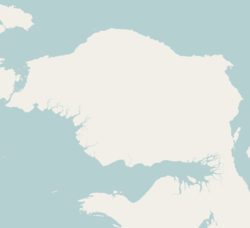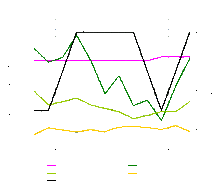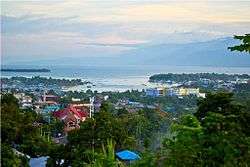Manokwari
| Manokwari | |
|---|---|
| City | |
|
Manokwari, as seen from the summit of Table Mountain. | |
 Manokwari Location of the town in the Bird's Head Peninsula | |
| Coordinates: 0°52′S 134°05′E / 0.867°S 134.083°E | |
| Country | Indonesia |
| Province | West Papua |
| Regency | Manokwari Regency |
| Founded | 1868 |
| Elevation | 37 m (121 ft) |
| Population (2010) | |
| • City | 136,302 |
| • Metro | 286,079 |
| Time zone | WIT (UTC+9) |
| Area code(s) | 0986 |
Manokwari is a city in Indonesia. It is the largest city and, since 2003, the capital of the province of West Papua, at the western end of New Guinea. The city has many resorts and is a major tourist area. It is one of the seats of the Roman Catholic Diocese of Manokwari–Sorong. It is also the administrative seat of Manokwari Regency. The city is also included of the Manokwari-Northeastern Bird's Head Peninsula MSA. It is the largest city in the metro area. The city is also a major port, financial center, and tourist area that is important to West Papua and Eastern Indonesia.
History
On 12 April 1942, a Japanese convoy steamed into Dore Bay and began landing approximately 4,000 men. The area was already well-known to the Japanese, as the area was the location of a cotton plantation developed by the government-sponsored Nan’yō Kōhatsu development company from the early 1930s.[1] At the beginning of 1942, the Royal Netherlands East Indies Army (KNIL) garrison at Manokwari consisted of approximately 125 KNIL troops, which included a number of civilians reservists and home guard who had been called up at the start of February 1942.[2] As the KNIL ground force had no chance of successfully engaging the Japanese invasion force, it withdrew into the interior of Dutch New Guinea and initiated guerilla warfare.[2]
At 4:43am on 4 January 2009 a magnitude 7.6 earthquake struck Manokwari. Felt as far away as Australia, the 35 km deep earthquake killed four people, injured 19 more and 167,000 people were left without power. Local residents were evacuated to Manokwari Military Academy in order to seek shelter from possible tsunamis and aftershocks that were felt throughout the day. Damage occurred to the Mutiara Hotel, the Naval hospital, and several other buildings. Manokwari Regional Airport had significant damage, being closest to the epicenter, and all four deaths resulted there. The Indonesian government sent a team of seven doctors to Manokwari to assist with the injured. Originally, the team was projected to be ten people, but due to the severe damage of the runway only seven were able to be transported in.[3] This was not unlike the previous quakes on 10 October 2002 when another 7.6 magnitude quake shook the region. In 1996 similar quakes also halted progress in the local region but there is no record of the recorded magnitude.[4]
On 14 April 2010, Merpati Nusantara Airlines flight MZ 836, a Boeing 737-300 (registration PK-MDF) with 103 persons on board, broke into pieces as it bounced off the tarmac at Rendani Airport near Manokwari after landing in poor weather. The tail of the aircraft broke off and came to rest in the creek off the northern end of Runway 35. All passengers survived, but 21 injured people were admitted to hospital. The flight originated in Sorong, West Papua.[5][6]
Climate

Manokwari is three meters above sea level on the coast of West Papua. Its average temperature is 26.3 °C (79.3 °F) and its temperature fluctuation is only 1 °C. It receives 2,597 mm (102.2 in) of rain per year, approximately 216 mm (8.5 in) per month. It is located 52 minutes (0.87 degrees, slightly less than 100 km) south of the equator and has an 86.3% average humidity. The annual sunshine hours are 2127; an average of 5.8 hours of sunlight per day. To date, there are no recorded days of frost or snowfall in Manokwari.[7]
| Climate data for Manokwari, West Papua, Indonesia (193 m asl) | |||||||||||||
|---|---|---|---|---|---|---|---|---|---|---|---|---|---|
| Month | Jan | Feb | Mar | Apr | May | Jun | Jul | Aug | Sep | Oct | Nov | Dec | Year |
| Average high °C (°F) | 29.9 (85.8) |
29.6 (85.3) |
29.6 (85.3) |
30.0 (86) |
30.1 (86.2) |
29.7 (85.5) |
29.4 (84.9) |
29.3 (84.7) |
29.8 (85.6) |
30.5 (86.9) |
30.5 (86.9) |
30.3 (86.5) |
29.89 (85.8) |
| Daily mean °C (°F) | 25.9 (78.6) |
25.9 (78.6) |
25.9 (78.6) |
26.1 (79) |
26.2 (79.2) |
25.9 (78.6) |
25.6 (78.1) |
25.4 (77.7) |
25.7 (78.3) |
26.2 (79.2) |
26.3 (79.3) |
26.2 (79.2) |
25.94 (78.7) |
| Average low °C (°F) | 21.9 (71.4) |
22.2 (72) |
22.3 (72.1) |
22.3 (72.1) |
22.3 (72.1) |
22.1 (71.8) |
21.8 (71.2) |
21.6 (70.9) |
21.7 (71.1) |
21.9 (71.4) |
22.1 (71.8) |
22.1 (71.8) |
22.03 (71.64) |
| Average precipitation mm (inches) | 264 (10.39) |
247 (9.72) |
296 (11.65) |
304 (11.97) |
210 (8.27) |
198 (7.8) |
160 (6.3) |
167 (6.57) |
140 (5.51) |
122 (4.8) |
141 (5.55) |
266 (10.47) |
2,515 (99) |
| Average relative humidity (%) | 86 | 85 | 86 | 86 | 86 | 85 | 87 | 87 | 86 | 84 | 85 | 86 | 85.8 |
| Source #1: Climate-Data.org (temp & precip)[8] | |||||||||||||
| Source #2: Weatherbase (humidity)[9] | |||||||||||||
Demographic information
There are over twenty-four different tribal groups living in Manokwari. Each tribe has its own unique language and culture. The most prominent of the tribal groups are the Asmat and the Dani tribes people. The traditional house of Papua is the Honai, a rounded house made of a wood and grass roof covering. Due to the variety of cultures in Manokwari, several different regional instruments have been popularized to include the Atowo, Tifa and the Fu. Manokwari is an urbanized region, but in several of the regencies you can still find traditional garb. A Koteka is a hollowed out gourd used by tribesmen to cover their genitals. These tribal people are well known for their wooden sculptures of virility and beauty. These sculptures are sold both locally and globally and are part of Manokwari's exports. Among the other tribes are Kuri, Simuri, Irarutu, Sebyar, Mascona, Mairasi, Kambouw, Onim, Sekar, Maibrat, Tohit, Imeko, Moi, Tipin, Maya, and Biak.[10]
Education
The State University of Papua was established on 3 November 2000. This university was created to help with the local education of the people of Papua. Among their achievements is the Beccariana, an academic journal published by the university.[11] This publication contains all the research done by the university in the field of herbalism. The university is strategically located on a hill facing the city, surrounded by a dense tropical rain forest. This allows the researchers instant access to the biological samples and case studies.[12]
Sister cities
| City | Country |
|---|---|
| Podgorica | |
| Thimpu | |
Derived name
The land flatworm Platydemus manokwari was named after the city (where it was found) by French zoologist de Beauchamp in 1962.
| Wikimedia Commons has media related to Manokwari. |
Tourism
One tourist site is the white, sandy Doreri Bay Beach which has calm, shallow water and is very safe for swimming.[13]
References
- ↑ Post, The Encyclopedia of Indonesia in the Pacific War , pages 560-561;
- 1 2 L, Klemen (1999–2000). "The capture of Manokwari, April 1942". Forgotten Campaign: The Dutch East Indies Campaign 1941-1942.
- ↑ Health Ministry sends Makassar medical team to Manokwari, 23 October 2011
- ↑ Earthquakes lay waste to Manokwari, kill four, 23 October 2011
- ↑ Plane skids off runway in Indonesia, ABC Online, 13 April 2010
- ↑ Merpati Boeing 737 skids off the runway at Manokwari, Miyuru ( K FLYER ), airlineindustryreview.com, 13 April 2010
- ↑ Climate and Temperature, 23 October 2011
- ↑ "Climate: Manokwari". Climate-Data.org. Retrieved 19 May 2016.
- ↑ "MANOKWARI, INDONESIA". Weatherbase. Retrieved 19 May 2016.
- ↑ Discover Indonesia, 23 October 2011
- ↑ Beccerina, 23 October 2011
- ↑ State University of Papua, 23 October 2011
- ↑ Ipul Gassing (April 22, 2015). "Charming White Sand Beach in Manokwari".
Coordinates: 0°52′S 134°05′E / 0.867°S 134.083°E
